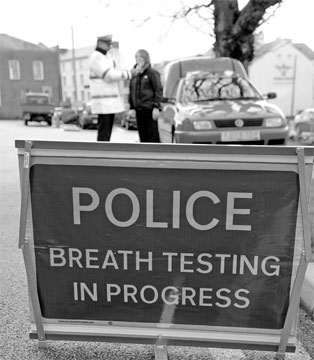A more dynamic liquor policy, an urgent need
by Lionel WIJESIRI
Delivering a lecture on ‘Alcohol Consumption and Consequences in Sri
Lanka’ a few months ago, Consultant Physician, Sri Jayawardanapura
General Hospital, Dr. Anula Wijesundere touched on the history of
alcohol consumption in Sri Lanka.
 She said: “Historic and cultural evidence indicates that Sri Lankans
did not consume alcohol significantly for several centuries and lived by
Buddhist principles, observing the five precepts. However, in 1505, with
the Portuguese invasion of Sri Lanka, the situation changed. They
destroyed our civilisation and influenced the drinking habit among Sri
Lankans. She said: “Historic and cultural evidence indicates that Sri Lankans
did not consume alcohol significantly for several centuries and lived by
Buddhist principles, observing the five precepts. However, in 1505, with
the Portuguese invasion of Sri Lanka, the situation changed. They
destroyed our civilisation and influenced the drinking habit among Sri
Lankans.
“The Dutch continued the propagation of alcohol, while the British
liberally introduced licences to open taverns in every nook and corner
of the country, increased their contribution to State coffers and
promoted the drinking habit widely via the ‘Toddy Act of 1912’.”
She also spoke about the magnitude of the problem. Sri Lanka has
extremely high rates of per capita consumption of alcohol – 7.4 litres
for recorded or licit alcohol. For males above 15 years, the consumption
rate is 15.2 litres. The Alcohol and Drug Information Centre (ADIC) says
that 43 percent of urban dwellers, 65 percent of male estate workers, 25
percent of female estate workers and 50 percent of fathers of
schoolchildren consume alcohol in Sri Lanka.
Arrack consumption increased from 67.1 million litres in 2006 to 75.2
million litres in 2010, bottled toddy from 10.5 million litres in 2006
to 16 million litres in 2010, malt liquor (which is beer, stout and
porter) from 51.9 million litres in 2006 to 66.9 million litres in 2010
and sparkling wines from 375,739 litres in 2006 to 395,892 litres in
2010.
These figures do not include the production of illicit brew in the
country. The sale of hard liquor and beer in Sri Lanka is estimated to
have increased by about seven to eight percent in 2011 from the year
before. The Commissioner General of Excise indicated that the main
reasons for increased consumption are the re-opening of the markets in
the North and the East, more tourist arrivals and lower illicit alcohol
consumption.
Problems
This data clearly lead us to a larger and bigger picture. It’s about
an impending catastrophe we cannot ignore any more! More studies
indicate that health, social and economic harm from alcohol abuse is
widespread in our country. As the average use of alcohol has been on the
increase, it is imposing numerous challenges on our policymakers,
professionals, civil society and public health.
The wide range of social and health problems include depression,
injuries, cancer, cirrhosis, family disruption and loss of work
productivity among others. Medical analysts say that health and social
problems from alcohol abuse often affect others besides the drinker.
While men do the bulk of the drinking, women disproportionately suffer
the consequences, including alcohol-related domestic violence and
reduced family budgets.
The saddest part is that heavy alcohol use takes a particular toll on
our young, and has been linked to high rates of youthful criminal
behaviour and impaired ability to achieve educational qualifications.
Many deaths and much disease and suffering within families and
neighbourhoods could be prevented by reducing alcohol use.
|

A foreign police campaign to nab drunk drivers |
One more related matter is the volume of traffic accidents in Sri
Lanka. Over 6,000 people are killed (or grievously hurt) every year. At
least 40 percent of these accidents are alcohol-related, mainly with
intoxication on the part of the driver.
Liquor policy
What we urgently need today is a more dynamic liquor policy. The
legislation flowing from such a policy should be guided by the need to
decrease per capita consumption of alcohol.
In particular, the policy should involve an integrated approach which
cuts across departments and sectors as different tiers of Government.
In my opinion, this could easily be done through the National
Authority on Tobacco and Alcohol, which can bring together
representatives of Government departments, community organisations,
religious bodies, trade unions and the liquor industry at national
level.
Similar interaction will be required at provincial government, local
authority and community levels. Local authorities and representative
community organisations and fora should work together in ensuring that
the way in which liquor is distributed and sold limits the negative
externalities as well as in addressing the negative effects which have
already occurred.
Above all, religious formations can also play a key role in
addressing the devastation caused by alcohol in their communities and
must be encouraged to be integrally involved in these initiatives.
Externalities
Addressing externalities involves handling issues common to all
sectors, but particular interventions are needed for education on
alcohol-related effects on individuals, families and the community.
Firstly, there is a need for general education about the potentially
harmful effects of alcohol by means of the media, schools, public health
facilities, community organisations and other vehicles. Central to any
education initiative is the goal of community empowerment to enable
people to take control over their lives.
There is also a need for the expansion of a comprehensive education
program for people within the liquor industry, in particular those who
serve alcohol to the public. The program will need to cater for the
educational needs of both those in the formal industry as well as the
informal sector.
It is in this aspect that I would recommend a program on the lines of
‘Alcohol Awareness Month’ as practised in the USA. Alcohol Awareness
Month, held every April in USA, was founded by and has been sponsored by
NCADD since 1987 to increase public awareness and understanding aimed at
reducing the stigma that too often prevents individuals and families
from seeking help.
During the Alcohol Awareness Month, the National Council on
Alcoholism and Drug Dependence (NCADD) and NCADD’s National Network of
Affiliates reach out in communities across the country to bring the
American public information about alcohol and alcoholism as a chronic,
progressive disease, fatal if untreated, and genetically predisposed.
The disease of alcoholism is a family disease that is treatable, not a
moral weakness, from which people can and do recover. In fact, millions
of individuals and family members are enjoying lives in long-term
recovery from alcoholism!
In 2012, the NCADD celebrated the 26th anniversary of the Alcohol
Awareness Month under the theme, ‘Healthy Choices, Healthy Communities:
Prevent Underage Drinking’. NCADD President/CEO, Robert J. Lindsey said,
“We chose a theme that will allow NCADD’s National Network of Affiliates
and other NCADD Alcohol Awareness Month supporting organisations across
the country to address this critically important public health issue
through a broad range of media strategies, awareness campaigns, programs
and events in their local communities.”
In support of the NCADD National Network of Affiliates and other
organisations who wish to work in support of the campaign, NCADD has
developed some NCADD Alcohol Awareness Month resource materials
including an Organiser’s Guide containing suggested grassroots community
activities.
Keys
It’s well established that two of the key ways to reduce alcohol
related harm are increasing the price of alcohol and restricting its
physical availability. The Government has initiated action on the first
point, but the public would also like to see changes to the licensing
laws that will give local authorities greater powers to control the
density of outlets selling alcohol.
The gradual relaxing of licensing laws in the past has meant it’s
much easier to get hold of alcohol, with an increased number, size and
type of licensed premises meaning that town and city centres can
accommodate more and more drinkers. Unfortunately, this comes at a cost,
namely increased rates of binge drinking and alcohol-related violence,
and consequently many regard our town centres as a place to avoid at
night. In its alcohol strategy, the authorities should recognise that
local communities should limit outlet density where this contributes to
harm. Ultimately, the goal is to find an acceptable balance between an
attractive and vibrant night-time economy and one that is not dominated
by the sale and consumption of alcohol. |

